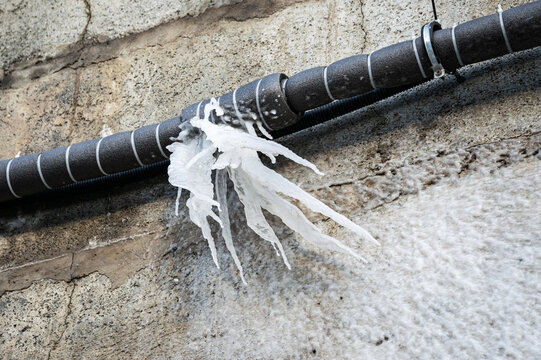Preventing Pipes from Freezing: Best Methods
Preventing Pipes from Freezing: Best Methods
Blog Article
In this article further down you might get a good deal of first-rate details relating to How to Prevent Your Pipes From Freezing.

Winter can damage your plumbing, specifically by freezing pipelines. Below's just how to avoid it from taking place and what to do if it does.
Intro
As temperature levels decline, the danger of icy pipelines boosts, potentially resulting in pricey repair services and water damages. Recognizing just how to stop icy pipelines is important for homeowners in cold climates.
Prevention Tips
Shielding vulnerable pipelines
Wrap pipes in insulation sleeves or use warmth tape to protect them from freezing temperature levels. Focus on pipes in unheated or outside locations of the home.
Home heating methods
Maintain interior rooms sufficiently warmed, specifically areas with plumbing. Open cabinet doors to allow cozy air to distribute around pipes under sinks.
How to recognize icy pipelines
Search for decreased water circulation from taps, unusual odors or sounds from pipelines, and visible frost on revealed pipelines.
Long-Term Solutions
Structural modifications
Take into consideration rerouting pipelines away from exterior wall surfaces or unheated areas. Add extra insulation to attic rooms, cellars, and crawl spaces.
Updating insulation
Invest in high-quality insulation for pipelines, attics, and wall surfaces. Proper insulation assists preserve regular temperatures and reduces the threat of frozen pipelines.
Shielding Outside Pipes
Garden hoses and outdoor taps
Separate and drain pipes garden tubes before winter. Install frost-proof spigots or cover exterior taps with protected caps.
Understanding Icy Pipelines
What creates pipelines to freeze?
Pipes freeze when exposed to temperature levels below 32 ° F (0 ° C) for expanded periods. As water inside the pipelines ices up, it increases, taxing the pipeline wall surfaces and possibly triggering them to break.
Threats and damages
Icy pipelines can lead to supply of water disruptions, property damage, and pricey fixings. Burst pipes can flooding homes and cause considerable structural damages.
Signs of Frozen Pipes
Identifying frozen pipelines early can stop them from bursting.
What to Do If Your Pipelines Freeze
Immediate actions to take
If you think frozen pipelines, maintain faucets open to relieve stress as the ice melts. Make use of a hairdryer or towels soaked in warm water to thaw pipes gradually.
Final thought
Protecting against icy pipelines calls for proactive measures and fast feedbacks. By understanding the reasons, indications, and safety nets, home owners can protect their pipes during winter.
6 Proven Ways to Prevent Frozen Pipes and Protect Your Home
Disconnect and Drain Garden Hoses
Before winter arrives, start by disconnecting your garden hoses and draining any remaining water. Close the shut-off valves that supply outdoor hose bibs and leave the outdoor faucet open to allow any residual water to drain. For extra protection, consider using faucet covers throughout the colder months. It’s also important to drain water from any sprinkler supply lines following the manufacturer’s directions.
Insulate Exposed Pipes
Insulating your pipes is an effective way to prevent freezing. Pipe insulation is readily available at home improvement stores and is relatively inexpensive. Pay close attention to pipes in unheated areas such as the attic, basement, crawl spaces, or garage. Apply foam insulation generously to create a buffer against the cold. You can also wrap your pipes in heat tape or thermostat-controlled heat cables for added warmth.
Seal Air Leaks
Inspect your home for any cracks or openings that could let in cold air. Seal any holes around the piping in interior or exterior walls, as well as the sill plates where your home rests on its foundation. Additionally, make sure to keep your garage door closed unless you’re entering or exiting. Leaving it open creates a significant air leak that can lead to frozen pipes.
Allow Warm Air Circulation
During cold snaps, it’s essential to allow warm air to circulate evenly throughout your home. Leave interior doors ajar to promote better airflow. Open kitchen and bathroom cabinets to help distribute heat consistently around the rooms. If you have small children or pets, be sure to remove any household chemicals or potentially harmful cleaners from open cabinets for safety.
Let Faucets Drip
A small trickle of water can make a big difference in preventing ice formation inside your pipes. When temperatures drop significantly, start a drip of water from all faucets served by exposed pipes. This continuous flow helps prevent the water from freezing. Additionally, running a few faucets slightly can relieve pressure inside the pipes, reducing the chances of a rupture if the water inside does freeze.
https://choateshvac.com/6-proven-ways-to-prevent-frozen-pipes-and-protect-your-home/

I am very inquisitive about Preventing and dealing with frozen pipes and I really hope you appreciated the article. Sharing is good. You just don't know, you may very well be doing someone a favor. Thanks for going through it.
Schedule Service Pickup Report this page